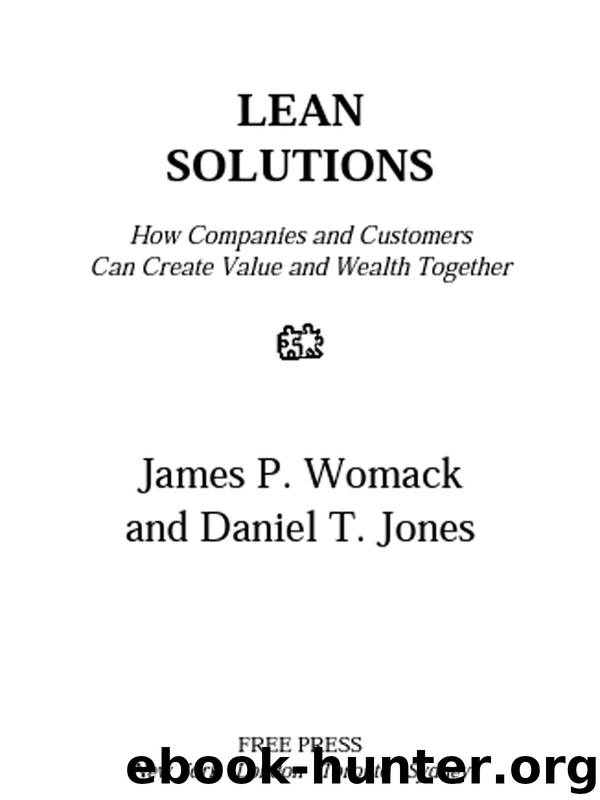Lean Solutions: How Companies and Customers Can Create Value and Wealth Together by James P. Womack & Daniel T. Jones

Author:James P. Womack & Daniel T. Jones [Womack, James P.]
Language: eng
Format: mobi, epub
Publisher: Free Press
Published: 2009-11-30T14:00:00+00:00
Chapter 8
The Challenge of Lean Provision: The Role of the Manager
Let’s assume that as providers we really want to do the right thing for the consumer. That is, we want to get consumers exactly what they want, where they want it, and when they want it, so as to completely solve their problems without wasting their time. Let’s further assume that in doing this we are going to create successful businesses and be rewarded in the market with ample profits and a growing share of the consumers’ spending. All we need to do is to create smooth-flowing consumption streams matching up perfectly with smooth-flowing provision streams. These can create more value on many dimensions for the consumer while saving costs at every turn for the provider.
But just how can we make this happen?
Process Thinking as the Essential Complement to Strategic and Financial Thinking
Despite much talk about using cross-functional teams and matrix management to address customer needs, most businesses today are decidedly inward-looking and highly functional in their actual operations. They organize knowledge, assets, and careers by tightly bounded departments such as sales, marketing, product development, finance, personnel, operations, information technology, quality, and, sometimes, more. And all of these are oriented vertically toward the CEO and COO at the top of the organizational chart.
By contrast, the processes required to listen to the customer and to deliver the desired value run horizontally across departments and functions. And they often run far beyond individual firms, through a number of independent organizations. These include the retailer, the distributor, and the manufacturer in fast-moving consumer goods; the HMO for primary care, the giant medical center for specialized treatments, and the equipment and drug suppliers in healthcare; and the airline, the outsourced maintenance organization, the airport operator, the aircraft manufacturer, and the rental car and limousine companies for long-distance travel. As we have seen, it’s very hard for functions, departments, and firms to work together horizontally with consumers to truly solve their problems.
That we haven’t made much progress in addressing this issue is not hard to understand when we look at the leaders of today’s value-creating organizations. We have interacted with many CEOs and COOs in recent years as part of our research, and we usually find that the senior leaders are most at home as either strategic thinkers or financial thinkers. In either case, they find it easiest to look at the problem from the standpoint of their own organization.
Senior leaders as strategic thinkers ask what customers can be serviced profitably with a firm’s existing assets, knowledge base, and geographical configuration. They often spend the bulk of their time selling assets—including managers and business units—no longer viewed as useful. Or they buy assets—including new managers and new businesses—likely to be needed for future initiatives. They often treat the actual value-creating processes used by the organization to solve the consumer’s problem as mere details best left to the functions to handle.
Alternatively, senior leaders as financial thinkers ask how the firm’s resources can be deployed to the right uses within the business units, functions, and departments.
Download
Lean Solutions: How Companies and Customers Can Create Value and Wealth Together by James P. Womack & Daniel T. Jones.epub
This site does not store any files on its server. We only index and link to content provided by other sites. Please contact the content providers to delete copyright contents if any and email us, we'll remove relevant links or contents immediately.
Bad Blood by John Carreyrou(6274)
Rich Dad Poor Dad by Robert T. Kiyosaki(6174)
Principles: Life and Work by Ray Dalio(5961)
Playing to Win_ How Strategy Really Works by A.G. Lafley & Roger L. Martin(5499)
Management Strategies for the Cloud Revolution: How Cloud Computing Is Transforming Business and Why You Can't Afford to Be Left Behind by Charles Babcock(4438)
The Confidence Code by Katty Kay(4036)
Thinking in Bets by Annie Duke(3996)
American Kingpin by Nick Bilton(3507)
Delivering Happiness by Tony Hsieh(3280)
Project Animal Farm: An Accidental Journey into the Secret World of Farming and the Truth About Our Food by Sonia Faruqi(3018)
The Power of Habit by Charles Duhigg(2966)
Brotopia by Emily Chang(2893)
Mastering Bitcoin: Programming the Open Blockchain by Andreas M. Antonopoulos(2891)
The Tyranny of Metrics by Jerry Z. Muller(2846)
I Live in the Future & Here's How It Works by Nick Bilton(2844)
The Marketing Plan Handbook: Develop Big-Picture Marketing Plans for Pennies on the Dollar by Robert W. Bly(2793)
The Content Trap by Bharat Anand(2778)
Building a StoryBrand by Donald Miller(2754)
Applied Empathy by Michael Ventura(2749)
